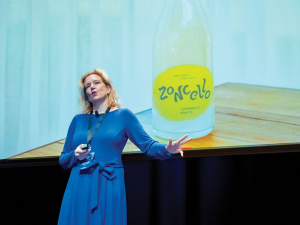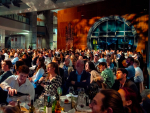In her typically energetic and engaging manner, Felicity Carter opened the Wine Business Forum with a fast-moving, thought-provoking session, ‘Navigating the Wine Lane on the Beverage Superhighway’.
Drawing on Charles Handy’s theory of 40- year industry life cycles, where the nimblest use the apex of the bell curve to leap into a new cycle, Felicity, who is founder of the Drinks Insider podcast and research consultancy and Editorial Director of Areni Global in London, argued that wine is now facing a structural inflection point.
Beginning with 1982, when Robert Parker first shook up the wine world, she highlighted numerous sea-changes, such as the impact that technically correct, reliable New World wines like Rosemount Chardonnay and Cloudy Bay Sauvignon Blanc had on global winemaking standards, the French paradox, the rise of wine tourism, and the booms in rosé and prosecco. She also noted missed opportunities, such as the lack of premiumisation options for ‘women in wine’, and the slow response to consumers’ growing health concerns and evolving drinking ‘occasions’.
Felicity observed that wine trends usually follow food trends. While dining options have exploded, wine has largely consolidated and homogenised its products, which has contributed to a major problem now besetting the industry – the disengagement of younger consumers. The MILZ (millennial/Gen Zs) demographic is highly health-conscious, open to different packaging and serving sizes, and is gravitating towards new options such as single serves, spritzers, wine cocktails and blended products. Yet they face a wine aisle dominated by often sugary commercialised wines that taste alike. Felicity advocated for wine to make a stronger connection to dining occasions, embrace innovation, including the growing role of technology in understanding consumer preferences, and leverage the burgeoning wine education sector to spark interest. She stressed the need to stand out in an increasingly crowded marketplace, suggesting that New Zealand is well-positioned to excel via premiumisation, wine tourism and sustainability. “Committing to something and standing for it is a way to survive in this market.” Key strategies included finding your voice, nurturing a culture and audience that understands taste and quality, and having extreme ambition and flagship wines, while distinguishing between “expensive highly-marketed wines, and true greatness”. Felicity was equally emphatic that commoditisation was disastrous. “Once you are in that space there is no way back up, you wreck it and you wreck it for a generation… you won’t get that prestige back.”
Andrew Shedden, Head of Fine Wine at the AU$12.3 billion Endeavor Group, also packed in a wealth of insight, outlining the Australian market’s declining consumption, driven by changing demographics, drinking occasions and moderation trends (health and economic). With wine shrinking against craft beers, premixes and spirits, especially with the all-important MILZs, Andrew observed that other categories have adapted to modern consumer demands while wine has clung to traditional norms. “They have been good at breaking traditional shackles, but wine has held on to its shackles a lot more strongly. We need to challenge the rules that we put around wine.”
Andrew detailed trends towards lighter and more refreshing wine styles (both red and white) with rosé and sparkling maintaining popularity, although Champagne is struggling on price. Lighter wines under 10% ABV are growing (far more than non-alcoholic) as are spritzers like Zoncello, and naturally-flavoured wines. Large formats such as bagnums (1.5 litre boxless bags) have rocketed, due to their size, value and 30-day shelf life. Andrew emphasised that both “liquid innovation and format innovation”, via alternative packaging, flavours and drinking occasions, would be key to recruiting MILZ, who are expected to constitute half of Australia’s liquor consumers by 2028.
Like Felicity, he saw both opportunities and challenges for New Zealand wine, including sparkling wines looking to fill the vacuum behind Champagne. Pinot Gris, Pinot Noir and Chardonnay all had premium category headroom, and the increasing number of buttery Chardonnay drinkers might be lured away from United States labels. Sauvignon Blanc was a more complex picture, reliant on an older customer base, and with high category loyalty but very low brand loyalty. Andrew felt flagship wines were lacking. “Where is the price ladder? The luxury options that exist for Chardonnay do not for Sauvignon Blanc.” He urged producers to become relevant to emerging consumers, seize short term opportunities and market gaps, while strategising for long term innovation. “Brand New Zealand really does resonate with our consumers. How does your brand stand out in the competitive set – what point of difference do you offer?”
For more on the Wine Business Forum go to nzwine.com/en/initiativesevents/altogetherunique












